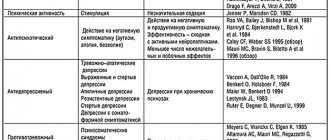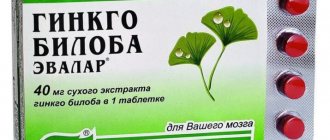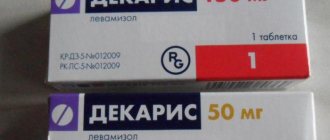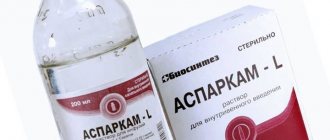pharmachologic effect
Sulpiride is an atypical antipsychotic from the group of substituted benzamides.
Sulpiride has moderate neuroleptic activity in combination with stimulating and thymoanaleptic (antidepressive) effects.
The neuroleptic effect is associated with an antidopaminergic effect. In the central nervous system, sulpiride predominantly blocks dopaminergic receptors of the limbic system, and has a slight effect on the neostriatal system; it has an antipsychotic effect. The peripheral effect of sulpiride is based on inhibition of presynaptic receptors. An increase in the amount of dopamine in the central nervous system is associated with an improvement in mood, and a decrease is associated with the development of symptoms of depression.
The antipsychotic effect of sulpiride is manifested in doses of more than 600 mg/day; in doses of up to 600 mg/day, the stimulating and antidepressant effect predominates.
Sulpiride does not have a significant effect on adrenergic, cholinergic, serotonin, histamine and GABA receptors.
In small doses, sulpiride can be used as an additional remedy in the treatment of psychosomatic diseases; in particular, it is effective in relieving the negative mental symptoms of gastric and duodenal ulcers. In irritable bowel syndrome, sulpiride reduces the intensity of abdominal pain and leads to an improvement in the patient's clinical condition.
Low doses of sulpiride (50-300 mg/day) are effective for dizziness, regardless of etiology. Sulpiride stimulates the secretion of prolactin and has a central antiemetic effect (suppression of the vomiting center) due to the blockade of dopamine D2 receptors in the trigger zone of the vomiting center.
Eglonil (in gastroenterology)
Eglonil
(eng.
Eglonil
) - an antipsychotic, a dopamine receptor blocker, used in gastroenterology as a prokinetic agent.
Dosage forms and composition of Eglonil
Eglonil is (was) approved in Russia in the form of the following dosage forms:
- tablets containing 200 mg of active substance - sulpiride
- capsules containing 50 mg sulpiride
- solution for intramuscular administration, in the form of ampoules containing 100 mg of sulpiride each
- oral solution in 200 ml glass bottles containing 1 mg of sulpiride (5 mg of sulpiride in 1 ml of solution)
In addition, Eglonil tablets contain excipients: potato starch, magnesium stearate, talc, lactose monohydrate, colloidal silicon dioxide, hypromellose.
Indications for use of Eglonil
In psychiatry and neurology:
- all forms of schizophrenia
- acute delirious states
- depression and neuroses
In psychiatry and neurology (50 mg capsules):
- children over 6 years of age: severe behavioral disorders (agitation, self-harm, stereotypy), especially in combination with autism syndromes
In gastroenterology (only as an additional remedy):
- psychosomatic symptoms in peptic ulcers of the stomach and duodenum, hemorrhagic rectocolitis and other diseases.
Method of use of Eglonil and dose in the treatment of the digestive system
In the treatment of gastroenterological diseases, Eglonil is used only as part of complex therapy. Eglonil in the treatment of GERD
. One of the main reasons leading to an increase in spontaneous relaxations of the lower esophageal sphincter is an increase in the level of neuroticism in patients suffering from GERD; testing is relevant to assess the personality profile and correct the identified disorders. To assess the personality profile of patients with pathological gastroesophageal reflux identified by pH-metry, psychological testing is carried out, on the basis of which the dependence of the nature and severity of gastroesophageal reflux on individual personality characteristics is revealed and, along with standard therapy, patients with a depressive personality type are prescribed Eglonil 50 mg 3 times a day, which improves the prognosis of the disease (Maev I.V. et al.). In the presence of psychoform disorders in the form of anxiety, fear, irritability, masked and overt depression, Eglonil 50 mg 2-3 times a day for 3-4 weeks is widely used for GERD. Eglonil is an atypical analeptic; it has a prokinetic effect on the motility of the esophagus of the stomach and intestines due to the blockade of dopaminergic receptors, which explains its antiemetic effect. In addition, eglonil has axiolytic (anti-anxiety) and antidepressant effects (Degtyareva I.I.).
Egonil in the treatment of duodenostasis in combination with hypomotor dyskinesia of the gallbladder
. For compensated and subcompensated duodenostasis, the prokinetic agents metoclopramide or domperidone are prescribed, in addition to which it is possible, especially in the presence of depressive states, to use Eglonil 50 mg 2-3 times a day or 2 ml of a 5% solution intramuscularly 1-2 times a day (Maev I .V., Samsonov A.A.).
In the treatment of peptic ulcer with symptoms of vegetative neurosis in children
Eglonil 0.005 mg per kg of the child’s weight in 2 doses, morning and afternoon, gives a good effect (Shabalov N.P.).
Comparison of Eglonil with other drugs regarding the effect on the electrical activity of the upper gastrointestinal tract
Using the Gastroscan-GEM gastroenteric monitor, a comparative study of the effect of Eglonil, the “classical” prokinetic agent Motilium and the myotropic antispasmodic Duspatalin on the electrical activity of the upper gastrointestinal tract was carried out. The data obtained is shown in the table below:
| A drug | Group affiliation | Pi/Ps | Kritm | Ai/As | Pi/Pi+1 | |||
| stomach | DPK | stomach | DPK | stomach | DPK | stomach/duodenal | ||
| Eglonil | antipsychotic | pad | pad | pad | pad | pad | pad | No |
| Motilium | prokinetic | height | pad | height | height | height | height | norm |
| Duspatalin | myotropic antispasmodic | pad | pad | No | No | No | No | No |
Abbreviations: growth
- the indicator of peripheral electrogastrography increases after taking the drug,
decline
- decreases,
no
- the drug does not affect the indicator,
normal
- taking the drug normalizes the indicator. For indicators of electrical activity—peripheral electrogastrography indicators Pi/Ps, Kritm, Ai/As and Pi/Pi+1, see “Electrogastroenterography: study of the electrical activity of the stomach and intestines.” Duodenum - duodenum.
Eglonil reduces the electrical activity Pi/Ps, the rhythmicity of Kritm and the amplitude of contractions Ai/As of both the stomach and duodenum. Prokinetic Motilium increases the electrical activity of the stomach Pi/Ps and reduces the electrical activity of the duodenum, increases the rhythmicity of Kritm contractions of the upper gastrointestinal tract and normalizes the coordination of contractions of the stomach and duodenum Pi/Pi+1. The myotropic antispasmodic Duspatolin reduces the electrical activity of the stomach and duodenum Pi/Ps and does not affect the rhythm of Kritm and the coordination of contractions Pi/Pi+1 of the upper gastrointestinal tract (Smirnova G.O.).
Eglonil, like other prokinetics, have a predominantly stimulating effect on the smooth muscles of the gastrointestinal tract. In particular, it increases the tone and contractile activity of the stomach and duodenum, improves antroduodenal coordination, accelerates the evacuation of gastric contents and small intestinal transit (Avdeev V.G.):
Rice.
The effect of Eglonil on the motor function of the duodenum (Avdeev V.G.) a - motility on an empty stomach, b - motility after administration of Eglonil; 1 — manometry in the upper horizontal part of the duodenum; 2 — pH-metry in the upper horizontal part of the duodenum; 3 — pH-metry in the distal part of the duodenum. On the website gastroscan.ru in the literature catalog there is a section “Prokinetics”, containing medical articles concerning the treatment of diseases of the gastrointestinal tract with various prokinetics, including Eglonil.
general information
According to the pharmacological index, Eglonil belongs to the group “Neuroleptics”.
According to ATC, Eglonil is included in the group “N05A Antipsychotic drugs” and has the code “N05AL01 Sulpiride”. Eglonil is available from pharmacies with a prescription.
Other drugs containing the active ingredient sulpiride
The following drugs with the active substance sulpiride are (have been) registered in Russia: Betamax, Vero-Sulpiride, Prosulpin, Sulpiride, Sulpiride Belupo, Eglek.
In the USA, Canada and Australia, sulpiride is not approved for use. In many countries of the European Union, Latin America and Southeast Asia it is sold under the trade name Dogmatil. In the UK - Dolmatil, Sulpiride and Sulpor. In Japan - Abilit, Betamac T, Dogmatyl, Keityl, Margenol, Miradol, Pyrikappl, Skanozen, Sulpiride Choseido, Sulpiride Kyowa Yakuhin, Sulpiride Taisho, Sulpiride Taiyo, Sulpiride Towa Yakuhin, Youmathyle, as well as under many other trade names in various countries around the world .
Eglonil has contraindications, side effects and application features; consultation with a specialist is necessary.
Back to section
Pharmacokinetics
With intramuscular administration of 100 mg of the drug, the Cmax of sulpiride in the blood plasma is achieved after 30 minutes and is 2.2 mg/l.
When administered orally, the Cmax of sulpiride in plasma is achieved after 3-6 hours and is 0.73 mg/l when taking 1 tablet containing 200 mg, and 0.25 mg/ml for 1 capsule containing 50 mg.
The bioavailability of dosage forms intended for oral administration is 25-35% and is characterized by significant individual variability.
Sulpiride has linear kinetics after doses ranging from 50 to 300 mg.
Sulpiride quickly diffuses into body tissues: visible Vd at steady state is 0.94 l/kg.
Plasma protein binding is approximately 40%.
Small amounts of sulpiride appear in breast milk and cross the placental barrier.
In the human body, sulpiride is metabolized only to a small extent: 92% of the administered intramuscular dose is excreted unchanged in the urine.
Sulpiride is excreted mainly through the kidneys, through pubertal filtration. Total clearance 126 ml/min. T1/2 of the drug is 7 hours.
Contraindications
- prolactin-dependent tumors (for example, pituitary prolactinomas and breast cancer);
- hyperprolactinemia;
- acute intoxication with ethanol, hypnotics, opioid analgesics;
— affective disorders, aggressive behavior, manic psychosis;
- pheochromocytoma;
- period of breastfeeding;
- children under 18 years of age (for tablets and solution for intramuscular administration);
- children under 6 years of age (for capsules);
- in combination with sultopride, dopaminergic receptor agonists (amantadine, apomorphine, bromocriptine, cabergoline, entacapone, lisuride, pergolide, piribedil, pramipexole, kinagolide, ropinirole);
- hypersensitivity to sulpiride or another ingredient of the drug.
Due to the presence of lactose in the drug, it is contraindicated in congenital galactosemia, glucose/galactose malabsorption syndrome or lactase deficiency.
Carefully:
It is not recommended to prescribe sulpiride to pregnant women, except in cases where the doctor, having assessed the balance of benefit and risk for the pregnant woman and the fetus, decides that the use of the drug is necessary.
It is not recommended to prescribe sulpiride in combination with ethanol, levodopa, drugs that can cause ventricular arrhythmias (antiarrhythmic drugs of class 1a (quinidine, hydroquinidine, disopyramide) and class III (amiodarone, sotalol, dofetilide, ibutilide)), some neuroleptics (thioridazein, chlorpromazine, levomepromazine, trifluoperazine, cyamemazine, amisulpride, tiapride, pimozide, haloperidol, droperidol) and other drugs such as: bepridil, cisapride, difemanil, intravenous erythromycin, mizolastine, intravenous vincamine, halofantrine, pentamidine, sparfloxacin, moxifloxacin, etc.
Precautions must be taken when prescribing sulpiride to patients with renal and/or liver failure, a history of neuroleptic malignant syndrome, a history of epilepsy or seizures, severe heart disease, arterial hypertension, patients with parkinsonism, dysmenorrhea, and the elderly.
Dosage
Solution for intramuscular administration
For acute and chronic psychoses
Treatment begins with intramuscular injections at a dose of 400-800 mg/day and is continued in most cases for 2 weeks. The goal of therapy is to achieve the minimum effective dose.
When administering sulpiride intramuscularly, the usual rules for intramuscular injections are followed: deep into the outer upper quadrant of the gluteal muscle, the skin is pre-treated with an antiseptic.
Depending on the clinical picture of the disease, intramuscular injections of sulpiride are prescribed 1-3 times a day, which can quickly alleviate or stop symptoms. As soon as the patient's condition allows, you should proceed to taking the drug orally. The course of treatment is determined by the doctor.
Tablets and capsules
Take 1-3 times a day with a small amount of liquid, regardless of meals.
The goal of therapy is to achieve the minimum effective dose.
It is not recommended to take the drug in the afternoon (after 16:00) due to an increase in activity level.
Pills
Acute and chronic schizophrenia, acute delirious psychosis, depression:
the daily dose is from 200 to 1000 mg, divided into several doses.
Capsules
Neuroses and anxiety in adults
patients:
the daily dose is from 50 to 150 mg for a maximum of 4 weeks.
Severe behavioral disorders in children
:
daily dose is from 5 to 10 mg/kg body weight.
Doses for the elderly:
The initial dose of sulpiride should be 1/4-1/2 the dose for adults.
Doses in patients with renal impairment
Due to the fact that sulpiride is excreted from the body primarily through the kidneys, it is recommended to reduce the dose of sulpiride and/or increase the interval between the administration of individual doses of the drug depending on the QC indicators:
| CC (ml/min) | Dose of Sulpiride compared to standard (%) | Increasing the interval between doses of Sulpiride |
| 30-60 ml/min | 70 | 1.5 times |
| 10-30 ml/min | 50 | 2 times |
| less than 10 ml/min | 30 | 3 times |
Indications for use
Eglonil is intended for the treatment of acute mental disorders.
As a short-term therapy to relieve aggression and agitation, the drug is used for such chronic disorders as:
- schizophrenia;
- hallucinatory psychosis;
- paranoid delusion.
In children over 6 years of age, the medicine is used for severe behavioral disorders: agitation, stereotypy, self-harm and other disorders, especially those arising against the background of autism.
Adults take the capsules for a short time for anxiety disorders.
Side effects
Adverse events that develop as a result of taking sulpiride are similar to adverse events caused by other psychotropic drugs, but the frequency of their development is generally less.
From the endocrine system:
the development of reversible hyperprolactinemia is possible, the most common manifestations of which are galactorrhea, amenorrhea, menstrual irregularities, and less often - gynecomastia, impotence and frigidity. During treatment with sulpiride, increased sweating and weight gain may occur.
From the digestive system:
increased activity of liver enzymes.
From the side of the central nervous system:
sedation, drowsiness, dizziness, tremor, early dyskinesia (spasmodic torticollis, oculogyric crises, trismus), which goes away with the appointment of an anticholinergic antiparkinsonian drug, rarely - extrapyramidal syndrome and associated disorders (akinesia, sometimes combined with muscle hypertonicity and partially eliminated with the appointment anticholinergic antiparkinsonian drugs, hyperkinesia-hypertonicity, motor agitation, akatasia). Cases of tardive dyskinesia, characterized by involuntary rhythmic movements, mainly of the tongue and/or face, have been reported during long courses of treatment, which can be observed during courses of treatment with all antipsychotics: the use of antiparkinsonian drugs is ineffective or may cause worsening of symptoms. If hyperthermia develops, the drug should be discontinued, because An increase in body temperature may indicate the development of neuroleptic malignant syndrome (NMS).
From the cardiovascular system:
tachycardia, possible increase or decrease in blood pressure, in rare cases, the development of orthostatic hypotension, prolongation of the QT interval, very rare cases of the development of “torsade depointes” syndrome.
Allergic reactions:
possible skin rash.
Side effects of the drug Eglonil
Sedation, drowsiness, early dyskinesia (spasmodic torticollis, oculogyric crises, trismus, which decrease with the administration of anticholinergic antiparkinsonian drugs), extrapyramidal symptoms, the severity of which partially decreases with the administration of anticholinergic antiparkinsonian drugs, tardive dyskinesia, which develops with long-term use of antipsychotics (anticholinergic antiparkinsonian drugs are ineffective and can worsen the patient’s condition), postural hypotension, impotence, frigidity, amenorrhea, galactorrhea, gynecomastia, hyperprolactinemia, weight gain.
Overdose
Experience with overdose of suilpiride is limited. Specific symptoms
absent, the following may be observed: dyskinesia with spasmodic torticollis, tongue protrusion and trismus, blurred vision, arterial hypertension, sedation, nausea, extrapyramidal symptoms, dry mouth, vomiting, increased sweating and gynecomastia, the development of NMS is possible. Some patients have parkinsonism syndrome.
Treatment:
sulpiride is partially eliminated by hemodialysis. Due to the lack of a specific antidote, symptomatic and supportive therapy should be used, with careful monitoring of respiratory function and constant monitoring of cardiac activity (risk of prolongation of the QT interval), which should continue until the patient fully recovers; centrally acting anticholinergics are prescribed for the development of severe extrapyramidal syndrome.
Drug interactions
Contraindicated combinations
Dopaminergic receptor agonists (amantadine, apomorphine, bromocriptine, cabergoline, entacapone, lisuride, pergolide, piribedil, pramipexole, kinagolide, ropinirole), except for patients suffering from Parkinson's disease:
There is mutual antagonism between dopaminergic receptor agonists and antipsychotics. For extrapyramidal syndrome induced by antipsychotics, dopaminergic receptor agonists are not used; in such cases, anticholinergics are used.
Sultopride:
the risk of ventricular arrhythmias, in particular atrial fibrillation, increases.
Combinations not recommended
Drugs that can cause ventricular arrhythmias: antiarrhythmic drugs of class Ia (quinidine, hydroquinidine, disopyramide) and class III (amiodarone, sotalol, dofetilide, ibutilide), some antipsychotics (thioridazine, chlorpromazine, levomepromazine, trifluoperazine, cyamemazine, amisulpride, tiapride, haloperidol, droperidol, pimozide) and other drugs such as: bepridil, cisapride, difemanil, intravenous erythromycin, mizolastine, intravenous vincamine, etc.
Ethanol:
enhances the sedative effect of neuroleptics. Impaired attention creates a danger for driving vehicles and working on machines. The consumption of alcoholic beverages and the use of medications containing ethyl alcohol should be avoided.
Levodopa:
mutual antagonism is observed between levodopa and antipsychotics. Patients suffering from Parkinson's disease should be prescribed the minimum effective dose of both drugs.
Dopaminergic receptor agonists (amantadine, apomorphine, bromocriptine, cabergoline, entacapone, lisuride, pergolide, piribedil, pramipexole, kinagolide, ropinirole), in patients suffering from Parkinson's disease:
There is mutual antagonism between dopaminergic receptor agonists and antipsychotics. The above drugs may cause or worsen psychosis. If treatment with an antipsychotic is necessary for a patient suffering from Parkinson's disease and receiving a dopaminergic antagonist, the dose of the latter should be gradually reduced until discontinuation (abrupt withdrawal of dopaminergic agonists can lead to the development of neuroleptic malignant syndrome).
Halofantrine, pentamidine, sparfloxacin, moxifloxacin:
the risk of ventricular arrhythmias, in particular “torsade de pointes”, increases. If possible, the antimicrobial drug causing ventricular arrhythmia should be discontinued. If the combination cannot be avoided, the QT interval should first be checked and ECG monitoring should be ensured.
Combinations requiring caution
Drugs that cause bradycardia (calcium channel blockers with bradycardic action: diltiazem, verapamil, beta-blockers, clonidine, guanfacine, digitalis alkaloids, cholinesterase inhibitors: donepezil, rivastigmine, tacrine, ambenonium chloride, galantamine, pyridostigmine, neostigmine):
the risk of ventricular arrhythmias, in particular “torsade de pointes”, increases. Clinical and ECG monitoring is recommended.
Drugs that reduce potassium levels in the blood (potassium-sparing diuretics, stimulant laxatives, amphoteric B (iv), glucocorticoids, tetracosactide):
the risk of ventricular arrhythmias, in particular “torsade de pointes”, increases. Before prescribing the drug, hypokalemia should be eliminated and clinical, cardiographic monitoring, as well as monitoring of electrolyte levels, should be established.
Combinations to consider:
Antihypertensive drugs:
enhancing the hypotensive effect and increasing the possibility of postural hypotension (additive effect).
Other CNS depressants:
morphine derivatives (analgesics, antitussives and replacement therapy), barbiturates, benzodiazepines and other anxiolytics, hypnotics, sedative antidepressants, sedative histamine H1 receptor antagonists, centrally acting antihypertensives, baclofen, thalidomide - central nervous system depression, impaired attention creates a danger for driving. and working on machines.
Sucralfate, antacids containing Mg2+ and/or A13+, reduce the bioavailability of oral dosage forms by 20-40%. Sulpiride should be prescribed 2 hours before taking them.
Eglonil 50 mg 30 pcs. capsules
pharmachologic effect
Antipsychotic (neuroleptic) drug.
Composition and release form Eglonil 50 mg 30 pcs. capsules
Capsules - 1 capsule:
- Active ingredients: sulpiride - 50 mg;
- Excipients: lactose monohydrate - 66.92 mg, methylcellulose - 580 mcg, talc - 1.3 mg, magnesium stearate - 1.2 mg;
- Composition of the capsule shell: gelatin - 98%, titanium dioxide (E171) - 2%.
15 pcs. - blisters (2) - cardboard packs.
Description of the dosage form
Hard gelatin capsules, size No. 4, opaque, white or white with a yellowish-grayish tint; the contents of the capsules are a homogeneous yellowish-white powder.
Directions for use and doses
Capsules are taken 1-3 times a day with a small amount of liquid, regardless of meals.
The goal of therapy is to achieve the minimum effective dose.
It is not recommended to take the drug in the afternoon (after 16:00) due to an increase in activity level.
Neuroses and anxiety in adult patients: the daily dose is from 50 to 150 mg for a maximum of 4 weeks.
Severe behavioral disorders in children: the daily dose is from 5 to 10 mg/kg body weight.
Doses for the elderly: the initial dose of sulpiride should be 1/4-1/2 the dose for adults.
Doses in patients with renal impairment
Due to the fact that sulpiride is excreted from the body primarily through the kidneys, it is recommended to reduce the dose of sulpiride and/or increase the interval between the administration of individual doses of the drug depending on the QC indicators:
| CC (ml/min) | Dose of Sulpiride compared to standard (%) | Increasing the interval between doses of Sulpiride |
| 30-60 ml/min | 70 | 1.5 times |
| 10-30 ml/min | 50 | 2 times |
| less than 10 ml/min | 30 | 3 times |
Pharmacodynamics
Sulpiride is an atypical antipsychotic from the group of substituted benzamides.
Sulpiride has moderate neuroleptic activity in combination with stimulating and thymoanaleptic (antidepressive) effects.
The neuroleptic effect is associated with an antidopaminergic effect. In the central nervous system, sulpiride predominantly blocks dopaminergic receptors of the limbic system, and has a slight effect on the neostriatal system; it has an antipsychotic effect. The peripheral effect of sulpiride is based on inhibition of presynaptic receptors. An increase in the amount of dopamine in the central nervous system is associated with an improvement in mood, and a decrease is associated with the development of symptoms of depression.
The antipsychotic effect of sulpiride is manifested in doses of more than 600 mg/day; in doses of up to 600 mg/day, the stimulating and antidepressant effect predominates.
Sulpiride does not have a significant effect on adrenergic, cholinergic, serotonin, histamine and GABA receptors.
In small doses, sulpiride can be used as an additional remedy in the treatment of psychosomatic diseases; in particular, it is effective in relieving the negative mental symptoms of gastric and duodenal ulcers. In irritable bowel syndrome, sulpiride reduces the intensity of abdominal pain and leads to an improvement in the patient's clinical condition.
Low doses of sulpiride (50-300 mg/day) are effective for dizziness, regardless of etiology. Sulpiride stimulates the secretion of prolactin and has a central antiemetic effect (suppression of the vomiting center) due to the blockade of dopamine D2 receptors in the trigger zone of the vomiting center.
Pharmacokinetics
With intramuscular administration of 100 mg of the drug, the Cmax of sulpiride in the blood plasma is achieved after 30 minutes and is 2.2 mg/l.
When administered orally, the Cmax of sulpiride in plasma is achieved after 3-6 hours and is 0.73 mg/l when taking 1 tablet containing 200 mg, and 0.25 mg/ml for 1 capsule containing 50 mg.
The bioavailability of dosage forms intended for oral administration is 25-35% and is characterized by significant individual variability.
Sulpiride has linear kinetics after doses ranging from 50 to 300 mg.
Sulpiride quickly diffuses into body tissues: visible Vd at steady state is 0.94 l/kg.
Plasma protein binding is approximately 40%.
Small amounts of sulpiride appear in breast milk and cross the placental barrier.
In the human body, sulpiride is metabolized only to a small extent: 92% of the administered intramuscular dose is excreted unchanged in the urine.
Sulpiride is excreted mainly through the kidneys, through pubertal filtration. Total clearance 126 ml/min. T1/2 of the drug is 7 hours.
Indications for use Eglonil 50 mg 30 pcs. capsules
As monotherapy or in combination with other psychotropic drugs:
- acute and chronic schizophrenia;
- acute delirious states;
- depression of various etiologies;
- neuroses and anxiety in adult patients, when conventional treatment methods are ineffective (only for 50 mg capsules);
- severe behavioral disorders (agitation, self-harm, stereotypy) in children over 6 years of age, especially in combination with autism syndromes (50 mg capsules only).
Contraindications
- prolactin-dependent tumors (for example, pituitary prolactinomas and breast cancer);
- hyperprolactinemia;
- acute intoxication with ethanol, hypnotics, opioid analgesics;
- affective disorders, aggressive behavior, manic psychosis;
- pheochromocytoma;
- breastfeeding period;
- children under 18 years of age (for tablets and solution for intramuscular administration);
- children under 6 years of age (for capsules);
- in combination with sultopride, dopaminergic receptor agonists (amantadine, apomorphine, bromocriptine, cabergoline, entacapone, lisuride, pergolide, piribedil, pramipexole, kinagolide, ropinirole);
- hypersensitivity to sulpiride or another ingredient of the drug.
Due to the presence of lactose in the drug, it is contraindicated in congenital galactosemia, glucose/galactose malabsorption syndrome or lactase deficiency.
Carefully:
It is not recommended to prescribe sulpiride to pregnant women, except in cases where the doctor, having assessed the balance of benefit and risk for the pregnant woman and the fetus, decides that the use of the drug is necessary.
It is not recommended to prescribe sulpiride in combination with ethanol, levodopa, drugs that can cause ventricular arrhythmias (antiarrhythmic drugs of class 1a (quinidine, hydroquinidine, disopyramide) and class III (amiodarone, sotalol, dofetilide, ibutilide)), some neuroleptics (thioridazein, chlorpromazine, levomepromazine, trifluoperazine, cyamemazine, amisulpride, tiapride, pimozide, haloperidol, droperidol) and other drugs such as: bepridil, cisapride, difemanil, intravenous erythromycin, mizolastine, intravenous vincamine, halofantrine, pentamidine, sparfloxacin, moxifloxacin, etc.
Precautions must be taken when prescribing sulpiride to patients with renal and/or liver failure, a history of neuroleptic malignant syndrome, a history of epilepsy or seizures, severe heart disease, arterial hypertension, patients with parkinsonism, dysmenorrhea, and the elderly.
Application of Eglonil 50 mg 30 pcs. capsules during pregnancy and breastfeeding
Experiments on animals did not reveal teratogenic effects. In a small number of women who took low doses of sulpiride (approximately 200 mg/day) during pregnancy, there was no teratogenic effect. There are no data available regarding the use of higher doses of sulpiride. There is also no data on the potential effect of antipsychotic drugs taken during pregnancy on fetal brain development. Therefore, as a precaution, it is preferable not to use sulpiride during pregnancy.
However, if this drug is used during pregnancy, it is recommended to limit the dose and duration of treatment as much as possible. In newborns whose mothers received long-term treatment with high doses of antipsychotics, gastrointestinal symptoms (bloating, etc.) associated with the atropine-like effect of certain drugs (especially in combination with antiparkinson drugs), as well as extrapyramidal syndrome, were rarely observed.
With prolonged treatment of the mother, or when using high doses, as well as in the case of prescribing the drug shortly before birth, monitoring the activity of the nervous system of the newborn is justified.
The drug passes into breast milk, so you should stop taking the drug during breastfeeding.
special instructions
Neuroleptic malignant syndrome: if hyperthermia of undiagnosed origin develops, sulpiride should be discontinued, as this may be one of the signs of the malignant syndrome described with the use of neuroleptics (pallor, hyperthermia, autonomic dysfunction, impaired consciousness, muscle rigidity).
Signs of autonomic dysfunction, such as increased sweating and labile blood pressure, may precede the onset of hyperthermia and therefore represent early warning signs.
Although this effect of antipsychotics may be idiosyncratic in origin, it appears that certain risk factors may predispose to it, such as dehydration or organic brain damage.
QT interval prolongation: Sulpiride prolongs the QT interval in a dose-dependent manner. This effect, which is known to increase the risk of developing serious ventricular arrhythmias such as torsade de pointes, is more pronounced in the presence of bradycardia, hypokalemia, or congenital or acquired QT prolongation (in combination with a drug known to prolong the QT interval).
If the clinical situation allows, it is recommended that before prescribing the drug, make sure that there are no factors that may contribute to the development of this type of arrhythmia:
- bradycardia with a number of beats less than 55 beats/min,
- hypokalemia,
- congenital prolongation of the QT interval,
- simultaneous treatment with a drug that can cause severe bradycardia (less than 55 beats/min), hypokalemia, slowing of intracardiac conduction or prolongation of the QT interval.
Except in cases of urgent intervention, patients who require treatment with antipsychotics are recommended to undergo an ECG during the assessment process.
Except in exceptional cases, this drug should not be used in patients suffering from Parkinson's disease.
In patients with impaired renal function, reduced doses should be used and monitoring should be increased; in severe forms of renal failure, intermittent courses of treatment are recommended.
Control during treatment with sulpiride should be strengthened:
- in patients with epilepsy, since the seizure threshold may be lowered;
- in the treatment of elderly patients who are more sensitive to postural hypotension, sedation and extrapyramidal effects.
Consumption of alcohol or use of medications containing ethyl alcohol during treatment with the drug is strictly prohibited.
Impact on the ability to drive vehicles and operate machinery
During treatment with Eglonil, driving vehicles and operating machinery that require increased attention, as well as drinking alcohol, is prohibited.
Overdose
Experience with overdose of suilpiride is limited.
There are no specific symptoms, but the following may be observed: dyskinesia with spasmodic torticollis, tongue protrusion and trismus, blurred vision, arterial hypertension, sedation, nausea, extrapyramidal symptoms, dry mouth, vomiting, increased sweating and gynecomastia, the development of NMS is possible. Some patients have parkinsonism syndrome.
Treatment: sulpiride is partially eliminated by hemodialysis. Due to the lack of a specific antidote, symptomatic and supportive therapy should be used, with careful monitoring of respiratory function and constant monitoring of cardiac activity (risk of prolongation of the QT interval), which should continue until the patient fully recovers; centrally acting anticholinergics are prescribed for the development of severe extrapyramidal syndrome.
Side effects Eglonil 50 mg 30 pcs. capsules
Adverse events that develop as a result of taking sulpiride are similar to adverse events caused by other psychotropic drugs, but the frequency of their development is generally less.
From the endocrine system: the development of reversible hyperprolactinemia is possible, the most common manifestations of which are galactorrhea, amenorrhea, menstrual irregularities, and less often - gynecomastia, impotence and frigidity. During treatment with sulpiride, increased sweating and weight gain may occur.
From the digestive system: increased activity of liver enzymes.
From the side of the central nervous system: sedation, drowsiness, dizziness, tremor, early dyskinesia (spasmodic torticollis, oculogyric crises, trismus), which goes away with the appointment of an anticholinergic antiparkinsonian drug, rarely - extrapyramidal syndrome and associated disorders (akinesia, sometimes combined with muscle hypertonicity and partially eliminated by prescribing anticholinergic antiparkinsonian drugs, hyperkinesia-hypertonicity, motor agitation, akatasia). Cases of tardive dyskinesia, characterized by involuntary rhythmic movements, mainly of the tongue and/or face, have been reported during long courses of treatment, which can be observed during courses of treatment with all antipsychotics: the use of antiparkinsonian drugs is ineffective or may cause worsening of symptoms. If hyperthermia develops, the drug should be discontinued, because An increase in body temperature may indicate the development of neuroleptic malignant syndrome (NMS).
From the cardiovascular system: tachycardia, possible increase or decrease in blood pressure, in rare cases, the development of orthostatic hypotension, prolongation of the QT interval, very rare cases of the development of “torsade depointes” syndrome.
Allergic reactions: possible skin rash.
Drug interactions
Contraindicated combinations
Dopaminergic receptor agonists (amantadine, apomorphine, bromocriptine, cabergoline, entacapone, lisuride, pergolide, piribedil, pramipexole, kinagolide, ropinirole), except for patients suffering from Parkinson's disease: there is mutual antagonism between dopaminergic receptor agonists and antipsychotics. For extrapyramidal syndrome induced by antipsychotics, dopaminergic receptor agonists are not used; in such cases, anticholinergics are used.
Sultopride: the risk of ventricular arrhythmias, in particular atrial fibrillation, increases.
Combinations not recommended
Drugs that can cause ventricular arrhythmias: antiarrhythmic drugs of class Ia (quinidine, hydroquinidine, disopyramide) and class III (amiodarone, sotalol, dofetilide, ibutilide), some antipsychotics (thioridazine, chlorpromazine, levomepromazine, trifluoperazine, cyamemazine, amisulpride, tiapride, haloperidol, droperidol, pimozide) and other drugs such as: bepridil, cisapride, difemanil, intravenous erythromycin, mizolastine, intravenous vincamine, etc.
Ethanol: enhances the sedative effect of neuroleptics. Impaired attention creates a danger for driving vehicles and working on machines. The consumption of alcoholic beverages and the use of medications containing ethyl alcohol should be avoided.
Levodopa: There is mutual antagonism between levodopa and antipsychotics. Patients suffering from Parkinson's disease should be prescribed the minimum effective dose of both drugs.
Dopaminergic receptor agonists (amantadine, apomorphine, bromocriptine, cabergoline, entacapone, lisuride, pergolide, piribedil, pramipexole, kinagolide, ropinirole), in patients suffering from Parkinson's disease: there is mutual antagonism between dopaminergic receptor agonists and antipsychotics. The above drugs may cause or worsen psychosis. If treatment with an antipsychotic is necessary for a patient suffering from Parkinson's disease and receiving a dopaminergic antagonist, the dose of the latter should be gradually reduced until discontinuation (abrupt withdrawal of dopaminergic agonists can lead to the development of neuroleptic malignant syndrome).
Halofantrine, pentamidine, sparfloxacin, moxifloxacin: the risk of ventricular arrhythmias, in particular torsade de pointes, increases. If possible, the antimicrobial drug causing ventricular arrhythmia should be discontinued. If the combination cannot be avoided, the QT interval should first be checked and ECG monitoring should be ensured.
Combinations requiring caution
Preparations that cause bradycardia (calcium channels with bradycardic effects: diltiazem, verapamil, beta-blockers, clonidine, guanfacin, alkaloids, cholinersterase inhibitors: dimensional, rivastigmin, ambenony chloride, galantamine, pyridostigmine): intensifies) The risk of ventricular arrhythmias , in particular "torsade de pointes". Clinical and ECG monitoring is recommended.
Drugs that reduce the level of potassium in the blood (potassium-sparing diuretics, stimulant laxatives, amphoteric B (iv), glucocorticoids, tetracosactide): increases the risk of ventricular arrhythmias, in particular “torsade de pointes”. Before prescribing the drug, hypokalemia should be eliminated and clinical, cardiographic monitoring, as well as monitoring of electrolyte levels, should be established.
Combinations to consider:
Antihypertensive drugs: increased hypotensive effect and increased possibility of postural hypotension (additive effect).
Other CNS depressants: morphine derivatives (analgesics, antitussives and replacement therapy), barbiturates, benzodiazepines and other anxiolytics, hypnotics, sedative antidepressants, sedative histamine H1 receptor antagonists, centrally acting antihypertensives, baclofen, thalidomide - depression of the central nervous system, creates impaired attention danger for driving vehicles and working on machines.
Sucralfate, antacids containing Mg2+ and/or A13+, reduce the bioavailability of oral dosage forms by 20-40%. Sulpiride should be prescribed 2 hours before taking them.
special instructions
Neuroleptic malignant syndrome:
if hyperthermia of undiagnosed origin develops, sulpiride should be discontinued, as this may be one of the signs of the malignant syndrome described with the use of antipsychotics (pallor, hyperthermia, autonomic dysfunction, impaired consciousness, muscle rigidity).
Signs of autonomic dysfunction, such as increased sweating and labile blood pressure, may precede the onset of hyperthermia and therefore represent early warning signs.
Although this effect of antipsychotics may be idiosyncratic in origin, it appears that certain risk factors may predispose to it, such as dehydration or organic brain damage.
Prolongation of the QT interval:
sulpiride prolongs the QT interval in a dose-dependent manner. This effect, which is known to increase the risk of developing serious ventricular arrhythmias such as torsade de pointes, is more pronounced in the presence of bradycardia, hypokalemia, or congenital or acquired QT prolongation (in combination with a drug known to prolong the QT interval).
If the clinical situation allows, it is recommended that before prescribing the drug, make sure that there are no factors that may contribute to the development of this type of arrhythmia:
- bradycardia with a number of beats less than 55 beats/min,
- hypokalemia,
- congenital prolongation of the QT interval,
- simultaneous treatment with a drug that can cause severe bradycardia (less than 55 beats/min), hypokalemia, slowing of intracardiac conduction or prolongation of the QT interval.
Except in cases of urgent intervention, patients who require treatment with antipsychotics are recommended to undergo an ECG during the assessment process.
Except in exceptional cases, this drug should not be used in patients suffering from Parkinson's disease.
In patients with impaired renal function, reduced doses should be used and monitoring should be increased; in severe forms of renal failure, intermittent courses of treatment are recommended.
Control during treatment with sulpiride should be strengthened:
- in patients with epilepsy, since the seizure threshold may be lowered;
- in the treatment of elderly patients who are more sensitive to postural hypotension, sedation and extrapyramidal effects.
Consumption of alcohol or use of medications containing ethyl alcohol during treatment with the drug is strictly prohibited.
Impact on the ability to drive vehicles and operate machinery
During treatment with Eglonil, driving vehicles and operating machinery that require increased attention, as well as drinking alcohol, is prohibited.
Pregnancy and lactation
Experiments on animals did not reveal teratogenic effects. In a small number of women who took low doses of sulpiride (approximately 200 mg/day) during pregnancy, there was no teratogenic effect. There are no data available regarding the use of higher doses of sulpiride. There is also no data on the potential effect of antipsychotic drugs taken during pregnancy on fetal brain development. Therefore, as a precaution, it is preferable not to use sulpiride during pregnancy.
However, if this drug is used during pregnancy, it is recommended to limit the dose and duration of treatment as much as possible. In newborns whose mothers received long-term treatment with high doses of antipsychotics, gastrointestinal symptoms (bloating, etc.) associated with the atropine-like effect of certain drugs (especially in combination with antiparkinson drugs), as well as extrapyramidal syndrome, were rarely observed.
With prolonged treatment of the mother, or when using high doses, as well as in the case of prescribing the drug shortly before birth, monitoring the activity of the nervous system of the newborn is justified.
The drug passes into breast milk, so you should stop taking the drug during breastfeeding.
Special instructions for the use of the drug Eglonil
If hyperthermia develops, sulpiride should be discontinued. Hyperthermia may be a manifestation of neuroleptic malignant syndrome (pallor, hyperthermia and autonomic dysfunction). This precaution is especially important when using the drug in high doses. Caution should be exercised when treating elderly patients who are more susceptible to the effects of the drug. Since sulpiride is excreted by the kidneys, in patients with severe renal failure the drug should be used in reduced doses and an intermittent treatment regimen should be used. Patients with epilepsy require more careful monitoring (clinical and, if necessary, EEG), since sulpiride reduces the seizure threshold. In patients with Parkinson's disease, sulpiride is prescribed with caution according to strict indications. In patients with aggressive behavior or agitation with impulsivity, sulpiride should be prescribed together with sedatives. In children whose mothers took low doses of sulpiride (approximately 200 mg/day) during pregnancy, no increase in the incidence of birth defects was observed. There is no experience with using the drug in higher doses. There is also no data on the potential effect of antipsychotic drugs taken during pregnancy on fetal brain development. It seems advisable, if possible, to reduce the dose and reduce the duration of treatment with the drug during pregnancy. In newborns whose mothers underwent long-term treatment with antipsychotics in high doses, several cases of the development of extrapyramidal syndrome have been described. It is recommended to monitor the neurological status of children born to mothers receiving the drug for some time after birth. Since sulpiride passes into breast milk, breastfeeding should be discontinued during treatment with the drug. Drivers of vehicles and persons working with potentially dangerous mechanisms should be warned about the possibility of developing drowsiness while taking the drug.







